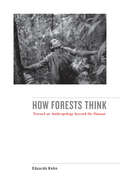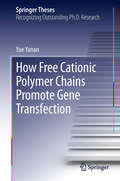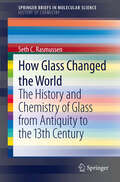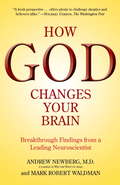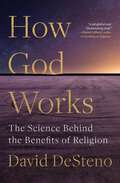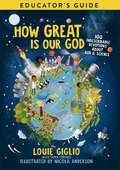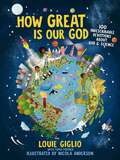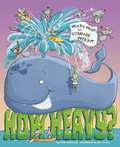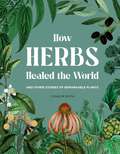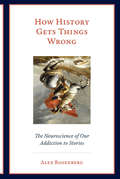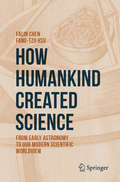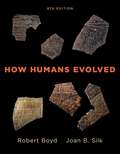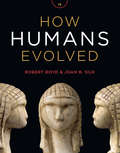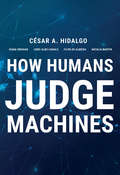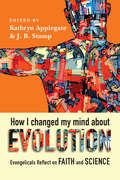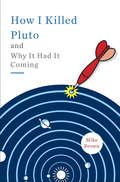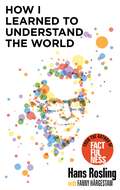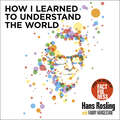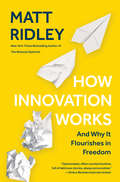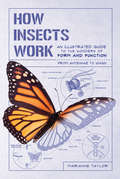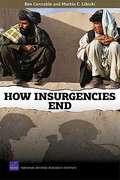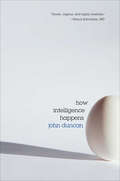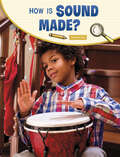- Table View
- List View
How Forests Think: Toward an Anthropology Beyond the Human
by Eduardo KohnCan forests think? Do dogs dream? In this astonishing book, Eduardo Kohn challenges the very foundations of anthropology, calling into question our central assumptions about what it means to be human—and thus distinct from all other life forms. Based on four years of fieldwork among the Runa of Ecuador’s Upper Amazon, Eduardo Kohn draws on his rich ethnography to explore how Amazonians interact with the many creatures that inhabit one of the world’s most complex ecosystems. Whether or not we recognize it, our anthropological tools hinge on those capacities that make us distinctly human. However, when we turn our ethnographic attention to how we relate to other kinds of beings, these tools (which have the effect of divorcing us from the rest of the world) break down. How Forests Think seizes on this breakdown as an opportunity. Avoiding reductionistic solutions, and without losing sight of how our lives and those of others are caught up in the moral webs we humans spin, this book skillfully fashions new kinds of conceptual tools from the strange and unexpected properties of the living world itself. In this groundbreaking work, Kohn takes anthropology in a new and exciting direction–one that offers a more capacious way to think about the world we share with other kinds of beings.
How Free Cationic Polymer Chains Promote Gene Transfection
by Yue YananIn this PhD thesis, Yue Yanan addresses a long-overlooked and critical question in the development of non-viral vectors for gene delivery. The author determines that those uncomplexed and cationic polymer chains free in the solution mixture of polymer and DNA facilitate and promote gene transfection. Furthermore, by using a combination of synthetic chemistry, polymer physics and molecular biology, Yue confirms that it is those cationic polymer chains free in the solution mixture, rather than those bound to DNA chains, that play a decisive role in intracellular trafficking. Instead of the previously proposed and widely accepted "proton sponge" model, the author's group propose a new hypothesis based on the results of several well-designed and decisive experiments. These results show that free polycationic chains with a length of more than ~10 nm are able to partially block the fusion between different endocytic vesicles, including the endocytic-vesicle-to-endolysosome pathway. This thesis is highly original and its results greatly deepen our understanding of polymer-mediated gene transfection. More importantly, it provides new insights into the rational design of next-generation superior polymeric gene-delivery vectors.
How Glass Changed the World
by Seth C. RasmussenGlass production is thought to date to ~2500 BC and had found numerous uses by the height of the Roman Empire. Yet the modern view of glass-based chemical apparatus (beakers, flasks, stills, etc.) was quite limited due to a lack of glass durability under rapid temperature changes and chemical attack. This "brief" gives an overview of the history and chemistry of glass technology from its origins in antiquity to its dramatic expansion in the 13th century, concluding with its impact on society in general, particularly its effect on chemical practices.
How God Changes Your Brain: Breakthrough Findings from a Leading Neuroscientist
by Andrew Newberg Mark Robert Waldman"How God Changes Your Brain" is a highly practical, easy-to-read guide on the interface between spirituality and neuroscience, filled with useful information that can make your brain and your life better. --Daniel G. Amen, M. D.
How God Works: The Science Behind the Benefits of Religion
by David DeStenoDrawing on a wealth of new evidence, pioneering research psychologist David DeSteno shows why religious practices and rituals are so beneficial to those who follow them—and to anyone, regardless of their faith (or lack thereof).Scientists are beginning to discover what believers have known for a long time: the rewards that a religious life can provide. For millennia, people have turned to priests, rabbis, imams, shamans, and others to help them deal with issues of grief and loss, birth and death, morality and meaning. In this absorbing work, DeSteno reveals how numerous religious practices from around the world improve emotional and physical well-being. With empathy and rigor, DeSteno chronicles religious rites and traditions from cradle to grave. He explains how the Japanese rituals surrounding childbirth help strengthen parental bonds with children. He describes how the Apache Sunrise Ceremony makes teenage girls better able to face the rigors of womanhood. He shows how Buddhist meditation reduces hostility and increases compassion. He demonstrates how the Jewish practice of sitting shiva comforts the bereaved. And much more. DeSteno details how belief itself enhances physical and mental health. But you don&’t need to be religious to benefit from the trove of wisdom that religion has to offer. Many items in religion&’s &“toolbox&” can help the body and mind whether or not one believes. How God Works offers advice on how to incorporate many of these practices to help all of us live more meaningful, successful, and satisfying lives.
How Great Is Our God Educator's Guide: 100 Indescribable Devotions About God and Science
by Louie GiglioHow Great Is Our God Educator's Guide is a companion to How Great Is Our God: 100 Indescribable Devotions About God and Science by Louie Giglio. This guide can be utilized in the classroom, in a home school setting, or by parents seeking additional resources. Ideal for grades 3rd-5th.
How Great Is Our God: 100 Indescribable Devotions About God and Science (Indescribable Kids)
by Louie GiglioShow the children in your life the awe-inspiring connection between the natural world and the God who created it. The bestselling children's devotional Indescribable: 100 Devotions About God and Science resonated with more than 200,000 kids, parents, and teachers. Now Louie Giglio offers 100 more devotions about God and science that will expand the curiosity of your 6- to 10-year-olds. Including amazing scientific facts, beautiful photography, fun illustrations, and simple activities, How Great Is Our God covers topics likeSpace and timeEarth and weatherThe human bodyAnimalsPlantsAnd more!With this science devotional, which is based on Giglio's well-known "How Great Is Our God" and “Indescribable” messages, children will embark on a journey to discover more about God and His incredible creation. From the pink lake in Senegal to the earth's trip around the sun to the water-holding frog that can live up to five years without a drink, the wonders of the universe will deepen your kids’ appreciation for God's wild imagination.
How Heavy?: Wacky Ways To Compare Weight (Wacky Comparisons)
by Terry Flaherty Bill Bolton Mark Weakland Advocate-Art StaffCompares various heavy objects to lighter objects in unique, illustrated ways.
How Herbs Healed the World: And Other Stories of Remarkable Plants
by Connor Smith'The writing shines when recounting the stories behind these herbs, offering a blend of history and botanical fascination' - RHS, The GardenHerbs are wonderful things. Without them so much would not be possible. With the advance of science over the last two hundred years these once mystical plants have changed and saved countless lives, vastly improving our standard of living while providing us all with a much richer, healthier diet. Today, we take for granted a world full oflife-saving drugs, luxury cosmetics and exotic foods.This fascinating book will tell this story: revealing how poisons once used by the ancient Romans such as Deadly Nightshade are now being used in modern medicine or how the herbs used by indigenous people around the world have provided remedies for countless illnesses. It will explore the myths and legends behind herbs such as the infamous Mandrake and how herbs such as Yarrow are still being used to treat wounds today, just as they were thousands of years ago; and it will show how exotic herbs from across the globe have enriched our livesand delve into the origins of the culinary herbs that everyone knows and loves.Seventy-five herbs have been carefully chosen to tell the story of how they have each changed our world, looking back at their origins and what was once believed, while comparing this with the modern day uses and the scientific value of these plants enabling the reader to understand and appreciate their importance.Each double page spread will provide both historic and modern illustrations of each herb alongside captivating accounts of their historical and modern day uses including supplementary botanical and horticultural information for each.
How Herbs Healed the World: And Other Stories of Remarkable Plants
by Connor Smith'The writing shines when recounting the stories behind these herbs, offering a blend of history and botanical fascination' - RHS, The GardenHerbs are wonderful things. Without them so much would not be possible. With the advance of science over the last two hundred years these once mystical plants have changed and saved countless lives, vastly improving our standard of living while providing us all with a much richer, healthier diet. Today, we take for granted a world full oflife-saving drugs, luxury cosmetics and exotic foods.This fascinating book will tell this story: revealing how poisons once used by the ancient Romans such as Deadly Nightshade are now being used in modern medicine or how the herbs used by indigenous people around the world have provided remedies for countless illnesses. It will explore the myths and legends behind herbs such as the infamous Mandrake and how herbs such as Yarrow are still being used to treat wounds today, just as they were thousands of years ago; and it will show how exotic herbs from across the globe have enriched our livesand delve into the origins of the culinary herbs that everyone knows and loves.Seventy-five herbs have been carefully chosen to tell the story of how they have each changed our world, looking back at their origins and what was once believed, while comparing this with the modern day uses and the scientific value of these plants enabling the reader to understand and appreciate their importance.Each double page spread will provide both historic and modern illustrations of each herb alongside captivating accounts of their historical and modern day uses including supplementary botanical and horticultural information for each.
How History Gets Things Wrong: The Neuroscience of Our Addiction to Stories (The\mit Press Ser.)
by Alex RosenbergWhy we learn the wrong things from narrative history, and how our love for stories is hard-wired.To understand something, you need to know its history. Right? Wrong, says Alex Rosenberg in How History Gets Things Wrong. Feeling especially well-informed after reading a book of popular history on the best-seller list? Don't. Narrative history is always, always wrong. It's not just incomplete or inaccurate but deeply wrong, as wrong as Ptolemaic astronomy. We no longer believe that the earth is the center of the universe. Why do we still believe in historical narrative? Our attachment to history as a vehicle for understanding has a long Darwinian pedigree and a genetic basis. Our love of stories is hard-wired. Neuroscience reveals that human evolution shaped a tool useful for survival into a defective theory of human nature. Stories historians tell, Rosenberg continues, are not only wrong but harmful. Israel and Palestine, for example, have dueling narratives of dispossession that prevent one side from compromising with the other. Henry Kissinger applied lessons drawn from the Congress of Vienna to American foreign policy with disastrous results. Human evolution improved primate mind reading—the ability to anticipate the behavior of others, whether predators, prey, or cooperators—to get us to the top of the African food chain. Now, however, this hard-wired capacity makes us think we can understand history—what the Kaiser was thinking in 1914, why Hitler declared war on the United States—by uncovering the narratives of what happened and why. In fact, Rosenberg argues, we will only understand history if we don't make it into a story.
How Humankind Created Science: From Early Astronomy to Our Modern Scientific Worldview
by Falin Chen Fang-Tzu HsuThe development of science has been an ideological struggle that lasted over three millennia. At and after the times of the Babylonian Empire, however, the pace of scientific evolution was painfully slow. This situation changed after Copernicus kick-started the Scientific Revolution with his heliocentric theory. Newton’s law of universal gravitation transformed natural philosophy, previously focused on mythology and abstract philosophical thinking, into an orderly and rational physical science. Einstein’s redefinition of space and time revealed a new and central principle of the Universe, paving the way for the huge amounts of energy held deep inside physical matter to be released. To this day, many of the our known physical theories represent an accumulation of changing knowledge over the long course of scientific history. But what kind of changes did the scientists see? What questions did they address? What methods did they use? What difficulties did they encounter? And what kind of persecution might they have faced on the road to discovering these beautiful, sometimes almost mystical, ideas? This book’s purpose is to investigate these questions. It leads the reader through the stories behind major scientific advancements and their theories, as well as explaining associated examples and hypotheses. Over the course of the journey, readers will come to understand the way scientists explore nature and how scientific theories are applied to natural phenomena and every-day technology.
How Humans Evolved
by Robert Boyd Joan B. SilkThis book focuses on the processes that have shaped human evolution. As anthropologists, the authors are interested in the evolutionary history of their own species. Homo sapiens and the diversity of contemporary human societies. As evolutionary biologists, the authors study how evolution works to shape the natural world. In this book, they integrate these two perspectives and use current theoretical and empirical work in evolutionary theory, population genetics and behavioral ecology to interpret human evolutionary history. They describe the changes that have occurred as the human lineage has evolved and consider why these changes may have happened. By focusing on the processes that generate change, create adaptations and shape bodies and behavior, they try to give life to the creatures that left the bones and made the artifacts that paleontologists and archaeologists painstakingly excavate. The authors also pay serious attention to the role of evolution in shaping contemporary human behavior. The list of references for further reading at the end of each chapter provides a starting point for students who want to delve more deeply into the material covered in that chapter.
How Humans Evolved (Seventh Edition)
by Robert Boyd Joan B. SilkGive students a complete picture of human evolution.
How Humans Judge Machines
by Cesar A. Hidalgo Diana Orghiain Jordi Albo Canals Filipa De Almeida Natalia MartinHow people judge humans and machines differently, in scenarios involving natural disasters, labor displacement, policing, privacy, algorithmic bias, and more.How would you feel about losing your job to a machine? How about a tsunami alert system that fails? Would you react differently to acts of discrimination depending on whether they were carried out by a machine or by a human? What about public surveillance? How Humans Judge Machines compares people's reactions to actions performed by humans and machines. Using data collected in dozens of experiments, this book reveals the biases that permeate human-machine interactions. Are there conditions in which we judge machines unfairly? Is our judgment of machines affected by the moral dimensions of a scenario? Is our judgment of machine correlated with demographic factors such as education or gender? César Hidalgo and colleagues use hard science to take on these pressing technological questions. Using randomized experiments, they create revealing counterfactuals and build statistical models to explain how people judge artificial intelligence and whether they do it fairly. Through original research, How Humans Judge Machines bring us one step closer tounderstanding the ethical consequences of AI.
How I Changed My Mind About Evolution: Evangelicals Reflect on Faith and Science (BioLogos Books on Science and Christianity)
by J. B. Stump Deborah Haarsma Kathryn ApplegateFrancis CollinsDeborah HaarsmaDenis LamoureuxJohn OrtbergKen FongLaura TruaxN. T. WrightScot McKnightTremper Longman IIIJames K. A. SmithAmos YongOliver Crisp
How I Killed Pluto and Why It Had It Coming
by Mike BrownThe solar system most of us grew up with included nine planets, with Mercury closest to the sun and Pluto at the outer edge. Then, in 2005, astronomer Mike Brown made the discovery of a lifetime: a tenth planet, Eris, slightly bigger than Pluto. But instead of its resulting in one more planet being added to our solar system, Brown's find ignited a firestorm of controversy that riled the usually sedate world of astronomy and launched him into the public eye. The debate culminated in the demotion of Pluto from real planet to the newly coined category of "dwarf" planet. Suddenly Brown was receiving hate mail from schoolchildren and being bombarded by TV reporters--all because of the discovery he had spent years searching for and a lifetime dreaming about. Filled with both humor and drama, How I Killed Pluto and Why It Had It Coming is Mike Brown's engaging first-person account of the most tumultuous year in modern astronomy--which he inadvertently caused. As it guides readers through important scientific concepts and inspires us to think more deeply about our place in the cosmos, it is also an entertaining and enlightening personal story: While Brown sought to expand our understanding of the vast nature of space, his own life was changed in the most immediate, human ways by love, birth, and death. A heartfelt and personal perspective on the demotion of everyone's favorite farflung planet, How I Killed Pluto and Why It Had It Coming is the book for anyone, young or old, who has ever dreamed of exploring the universe--and who among us hasn't?From the Hardcover edition.
How I Learned to Understand the World: BBC RADIO 4 BOOK OF THE WEEK
by Hans RoslingThis is a book that contains very few numbers. Instead, it is about meeting people who have opened my eyes.It was facts that helped him explain how the world works. But it was curiosity and commitment that made the late Hans Rosling, author of worldwide bestseller Factfulness, the most popular researcher of our time.How I Learned to Understand the World is Hans Rosling's own story of how a young scientist learned became a revolutionary thinker, and takes us from the swelter of an emergency clinic in Mozambique, to the World Economic Forum at Davos. In collaboration with Swedish journalist Fanny Härgestam, Hans Rosling wrote his memoir with the same joy of storytelling that made a whole world listen when he spoke.
How I Learned to Understand the World: BBC RADIO 4 BOOK OF THE WEEK
by Hans RoslingThis is a book that contains very few numbers. Instead, it is about meeting people who have opened my eyes.It was facts that helped him explain how the world works. But it was curiosity and commitment that made the late Hans Rosling, author of worldwide bestseller Factfulness, the most popular researcher of our time.How I Learned to Understand the World is Hans Rosling's own story of how a young scientist learned became a revolutionary thinker, and takes us from the swelter of an emergency clinic in Mozambique, to the World Economic Forum at Davos. In collaboration with Swedish journalist Fanny Härgestam, Hans Rosling wrote his memoir with the same joy of storytelling that made a whole world listen when he spoke.(P) 2020 Hodder & Stoughton Ltd
How Innovation Works: And Why It Flourishes in Freedom
by Matt RidleyBuilding on his national bestseller The Rational Optimist, Matt Ridley chronicles the history of innovation, and how we need to change our thinking on the subject.Innovation is the main event of the modern age, the reason we experience both dramatic improvements in our living standards and unsettling changes in our society. Forget short-term symptoms like Donald Trump and Brexit, it is innovation that will shape the twenty-first century. Yet innovation remains a mysterious process, poorly understood by policy makers and businessmen alike.Matt Ridley argues that we need to see innovation as an incremental, bottom-up, fortuitous process that happens as a direct result of the human habit of exchange, rather than an orderly, top-down process developing according to a plan. Innovation is crucially different from invention, because it is the turning of inventions into things of practical and affordable use to people. It speeds up in some sectors and slows down in others. It is always a collective, collaborative phenomenon, involving trial and error, not a matter of lonely genius. It happens mainly in just a few parts of the world at any one time. It still cannot be modeled properly by economists, but it can easily be discouraged by politicians. Far from there being too much innovation, we may be on the brink of an innovation famine.Ridley derives these and other lessons from the lively stories of scores of innovations, how they started and why they succeeded or failed. Some of the innovation stories he tells are about steam engines, jet engines, search engines, airships, coffee, potatoes, vaping, vaccines, cuisine, antibiotics, mosquito nets, turbines, propellers, fertilizer, zero, computers, dogs, farming, fire, genetic engineering, gene editing, container shipping, railways, cars, safety rules, wheeled suitcases, mobile phones, corrugated iron, powered flight, chlorinated water, toilets, vacuum cleaners, shale gas, the telegraph, radio, social media, block chain, the sharing economy, artificial intelligence, fake bomb detectors, phantom games consoles, fraudulent blood tests, hyperloop tubes, herbicides, copyright, and even life itself.
How Insects Work: An Illustrated Guide to the Wonders of Form and Function—from Antennae to Wings
by Marianne TaylorThe extraordinary inner-workings of the world&’s amazing, adaptable insectsA tiny textbook to learn on your ownHow Insects Work goes beyond the typical field guide to show us not only what insects look like but why. Arguably the most successful land animals—still going strong after five mass extinctions—insects have evolved a spectacular array of real-life superpowers to help them thrive in virtually every environment: Bumblebees&’ wingbeats leave a faint electrical signal at each flower they visit to show that the nectar&’s already been taken (see page 57), and houseflies defy gravity with tiny leg hairs that stick to the smoothest wall or ceiling (see page 69). In this in-depth, photo-filled handbook, discover the ways insects are even more astounding than you know—inside and out: EvolutionExoskeleton and Body SegmentsSensesCirculationDigestionRespirationReproductionMetamorphosisMovementAnd much, much more!
How Insurgencies End
by Martin C. Libicki Ben ConnableRAND studied 89 modern insurgency cases to test conventional understanding about how insurgencies end. Findings relevant to policymakers and analysts include that modern insurgencies last about ten years; withdrawal of state support cripples insurgencies; civil defense forces are useful for both sides; pseudodemocracies fare poorly against insurgents; and governments win more often in the long run.
How Intelligence Happens
by John DuncanA lively journey through the brain&’s inner workings from &“one of the world&’s leading cognitive neuroscientists&” (The Wall Street Journal). Human intelligence builds sprawling cities, vast cornfields, and complex microchips. It takes us from the atom to the limits of the universe. How does the biological brain, a collection of billions of cells, enable us to do things no other species can do? In this book, neuroscientist John Duncan offers an adventure story—the story of the hunt for basic principles of human intelligence, behavior, and thought. Using results drawn from classical studies of intelligence testing; from attempts to build computers that think; from studies of how minds change after brain damage; from modern discoveries of brain imaging; and from groundbreaking recent research, he synthesizes often difficult-to-understand information into clear, fascinating prose about how brains work. Moving from the foundations of psychology, artificial intelligence, and neuroscience to the most current scientific thinking, How Intelligence Happens is &“a timely, original, and highly readable contribution to our understanding&” (Nancy Kanwisher, MIT) from a winner of the Heineken Prize for Cognitive Science
How Is Sound Made? (Science Inquiry)
by Emily RaijSounds can be loud. Sounds can be soft. We use our ears to hear all kinds of sounds. But how is sound made? Let’s investigate to find out about sound!
How Is a Crayon Made?
by Oz CharlesEver wonder how crayons are made? Find out about all the steps that go into making your favorite crayons in this book!
